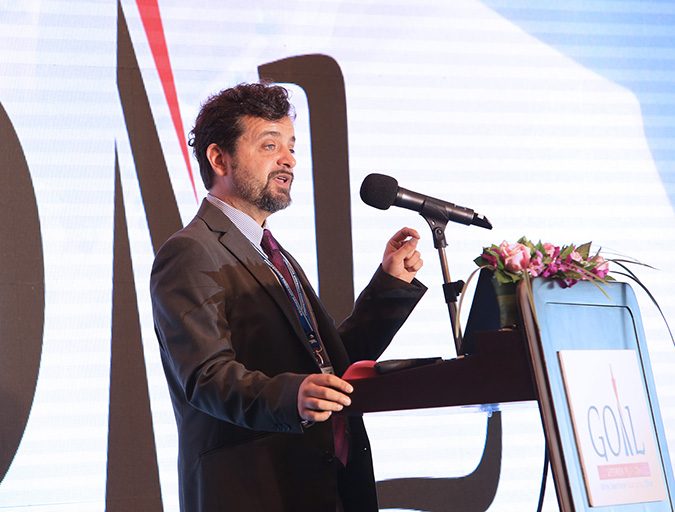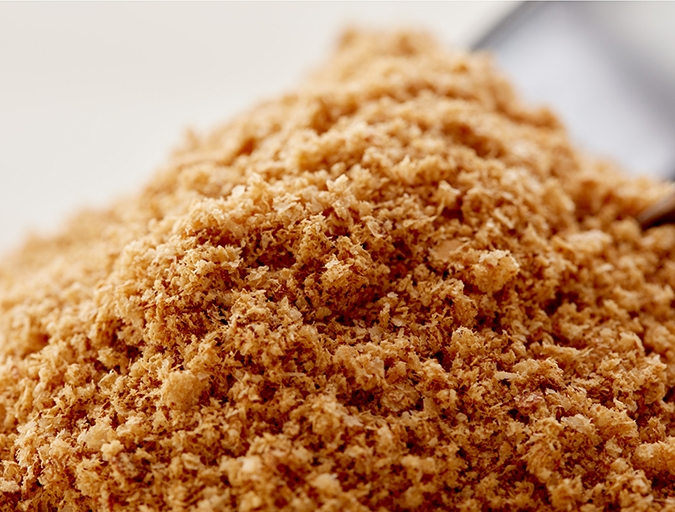‘If we find those essential fatty acids in other sources we can stop using fish oil, or use much less’

Giovanni Turchini once wanted to be a rocket scientist. Or maybe an astronaut. As an intelligent and curious child, however, Turchini was drawn to fish – during a vacation to the Alps with his family he became fascinated with the trout swimming in a pond and spent many hours that summer observing their behavior.
“I grew up in Milan, a big city with no water, no ocean, nothing,” Turchini told the Advocate. “I was desperate because I was missing the link with water.”
Realizing that his passion was in that pond, and not in the stars, Turchini embarked on an academic path that led him to become the associate head of research at the School of Life and Environmental Sciences at Deakin University (Australia), and one of the world’s leading experts on fish nutrition.
Speaking at the Global Aquaculture Alliance’s GOAL (Global Outlook for Aquaculture Leadership) conference in Guangzhou, China, in September, Turchini made the bold statement that aquaculture can succeed without marine-based ingredients – namely fishmeal and fish oil – in feeds. That’s only if we can move beyond the “bottleneck” of long-chain omega-3 fatty acid production.
Editor’s note: This is part 1 of a 2-part interview.
Aquaculture is a growth industry if there ever was one. The growing interest in the industry is good to see, isn’t it?
The industry is growing fast and is vibrant and dynamic. There is an increasing interest in the sector, but unfortunately, we can see some polarizing opinions about aquaculture. Those who know the sector are very much in favor. Those who don’t understand the sector see it as the new kid in town and like to bully. There’s lots of misleading information going around. Some sectors of aquaculture have some issues, some environmental issues, but others are doing very well. The problem is negative news impacts the entire industry.
What’s an example of an aquaculture sector in Australia that’s doing really well?
In Victoria, Australia, one of the Australian states with smallest aquaculture industry, there is one that is interesting: abalone. It’s a fantastic example of what we need to do in the future. It’s extremely sustainable, consumes no fishmeal or fish oil. They are a slow-growing animal, yes, but highly prized. A major part of the industry is land-based, in flow-through raceways, with good control of the water going in and coming out. The water going out is often of better quality than the water coming in – there’s a little bit less oxygen, but in terms of nutrients it’s fundamentally good. It’s a good example of a small sector that is generating wealth and good quality seafood.
Researchers from University of Stirling found that farmed salmon offer lower amounts of omega-3 fatty acids if fed standard diets, with lowered amounts of fishmeal and fish oil and greater amounts of terrestrial agriculture products than recorded years before. With this is mind, how do you envision a future for aquaculture without any fishmeal or fish oil inputs?
First I would like to say that some of the data I presented at GOAL 2016 were actually data coming from Stirling, the researchers [Matt Sprague and Douglas Tocher] shared with me some of their data. I would really like to thank them, as this is an excellent example of collaboration, with the only objective being that of supporting the sector. They had tried all possible ways to send positive news, saying, yes, there are less omega-3s compared to five years ago, but still it’s one of the best sources of omega-3s. The BBC report put lots of emphasis on the decrease in omega-3s.
It’s a complex question. There are a lot of things to be considered. First, I don’t envisage a complete stop of using fishmeal and fish oil in aquaculture. The reality is the amount of fishmeal and fish oil – particularly if we are keen to use sustainably sourced fishmeal and fish oil, which is what the sector is trying to do – is limited and we can’t expand production. Meanwhile, aquaculture is growing. Realistically, there is less fishmeal and fish oil available to be used in aquafeed. Some sectors of aquaculture can do very easily without it and others need some at the moment, because there isn’t an adequate replacement, which is the most limiting factor. When it comes to salmon, from a physiological point of view, you really need only extremely limited amounts of EPA and DHA, which are the long-chain omega-3 fatty acids, contained in fish oil. The fact is that if we find those essential fatty acids in other sources we can stop using fish oil, or use much less. That is one approach.
Realistically, there is less fishmeal and fish oil available to be used in aquafeed. Some sectors of aquaculture can do very easily without it and others need some at the moment, because there isn’t an adequate replacement, which is the most limiting factor.
Salmonids, like all freshwater fish or anadromous species, are able to biosynthesize long-chain omega-3s, starting from the shorter-chain omega-3s that you can find in linseed oil – alpha linolenic acid – which is not a bad fatty acid, but is not providing the same health benefit as the long-chain omega-3s, EPA and DHA. The first problem is some people say you don’t need to bother with fish because you can eat linseed, or other terrestrial plant sources of omega-3. That is not true; that omega-3 is not the same.
Humans are very bad at bio-converting, while fish are more efficient; salmonids in particular are quite efficient – if you like, you can farm a salmonid without any fish oil, or any long-chain omega-3s, provided you have the right amount of shorter-chain omega-3s. By the end you still have a product containing a decent amount of long-chain omega-3s.
I tried it with trout, for the entire production, from fingerlings to commercial-sized fish, without any fish oil, but the right amount of alpha linolenic acid. By the end, I still had a product with 500 mg of EPA and DHA per 100 grams of fillet. That trout contained roughly twice as much long-chain omega-3s compared with average wild marine fish.
That surprises me, as I’m sure it does others.
Yes, if you compare it with the past. Something we need to consider, and I always try to make the case – how often have you heard anyone asking a chick farmer if the nutritional quality of their product is the same as in a game bird? Or a pig, and how it compares to a wild boar? The reality is that aquaculture, being a new sector, is still always compared to the wild sector and also what was done 10 years ago. In reality, all the other food we eat, animals and plants, are totally and completely different from what they are in the wild. Aquaculture can produce a large amount of healthy food, simply not the same way as 20 years ago.
Is that the goal, to get to zero fishmeal and fish oil, or is that simply an ideal to chase and possibly never reach? Is that even realistic?
Absolutely it is realistic – we have no other options. It’s already happening – and with the growth of aquaculture, even more so in the future – there will be a split on the market. [A fishmeal/fish oil-fed fish] would be a niche product for a niche market, most likely, and it will sell at a higher price. Therefore, they can pay a higher price for the feed. They might be able to use some fishmeal and fish oil, and it could be the top end of the market. Then you will have the bulk of production that will have to be farmed differently. Still, we have a lot of alternative options, particularly when it comes to omega-3s. These technologies are coming. So, I don’t see an aquaculture product without omega-3s. But the origin of the omega-3s could be quite different than fish oil.
We’re already seeing those economic forces play out with nutraceuticals, which is taking the upper-crust quality fish oil supplies.
Exactly. We can’t ignore market forces, those that are shaping all the sectors of human activities. They are shaping aquaculture as well. If you have a group of consumers willing to pay a higher price for fillets from fish that were fed a higher amount of fishmeal and fish oil, you can do that. The big production will be using other sources.
The reduction fisheries that provide fishmeal and fish oil are often concerned when new feed formulations are touted as “fishmeal free,” which some could interpret as meaning that fishmeal is somehow unsafe. It’s a reasonable concern, and has changed the way I write about it. Have you encountered any pushback from the fishing industry for suggesting that fishmeal or fish oil is not needed?
It’s an important point. I believe the whole sector should try to work more collaboratively. The reality is that fishmeal and fish oil are outstanding raw materials – very precious and fantastic. There’s nothing wrong in using them, and that’s why in my talk I said it’s not an environmental issue for aquaculture to use fishmeal and fish oil, if they are produced in a sustainable and responsible way. These are fantastic resources, but we need to use less per unit of production; we need to use it more efficiently; we need to use less and make the most out of it. I know it is possible to make a feed without fishmeal and without fish oil and still have a decent product at the end. But I also know that if you use a little fishmeal and fish oil, you have a lot of advantages. It’s not bad to use fishmeal and fish oil, but the reality is there’s not enough. I understand that everybody is trying to protect their own markets, but we need to push the barrier more forward.
Aquaculture is such a diverse and beautiful industry, so many different species and so many different environments. You will always have some sector that will require some fishmeal and fish oil. But if other sectors move out entirely, that will be good for the overall sustainability and profitability.
The aquafeed industry is often caught in the middle, constantly receiving conflicting requests. They are asked to have low or zero fishmeal and fish oil, for sustainability reasons, and also massive amounts of omega-3s in the product. The only way to do that at the moment is to use fishmeal and fish oil in the feed. These forces pulling in either direction will eventually generate a split on the market. We could have a product like salmon, farmed completely differently – one product that is high in fishmeal and fish oil, one much less. Same species with different characteristics.
It is clear that if you put in front of a person two fish products, one fed fish oil and one without, that person will easily tell you there is a difference. If you gave the same person, the same two fish on two separate days, they won’t be able to tell the difference.
No fish, nor shrimp, needs any fishmeal, only essential amino acids, highly digestible energy sources and the correct protein/energy ratio, as you stated during your GOAL presentation. But what about flavor? If a fish is eating a nutritionally balanced and high-performance diet, but one that contains no fish, will flavor suffer? Should the industry be worried about this?
It’s another important point. The answer is yes; the industry needs to consider this aspect. There’s a couple of things we need to clarify. One is that – and I’ve done some studies on organoleptic properties – many people say, yes, if the quality of the fish they buy goes down, they won’t buy fish any more. However, sadly, people buy food relative to price, that is the first attribute. It’s all about price. You could have the most fantastic-tasting fish, but if it’s too expensive they won’t buy, and if you have a bland-tasting fish that’s cheap, they will buy. It’s the reality for the bulk of consumers. Foodies are more interested and place more emphasis on taste or environmental, social or ethical qualities of the products. From a technical point of view, the replacement of fishmeal has very little impact on the final flavor of the fish. Generally speaking, fishmeal is about protein. When we talk about protein, we are not what we eat – what we eat becomes us. That’s quite important. With protein, we take a bite and recompose that into muscle. If we eat beef, beans or fish, our muscle will have the same composition. It’s based on our genetic material.
When it comes to lipids, the story is different – we actually are what we eat. If we eat a different lipid, we will affect our lipid composition. The same, and to a greater extenct, applies to fish. When you replace fish oil, you affect the final fatty acid and lipid composition of the products. Replacing fishmeal has very little impact on the flavor. It’s important for the flavor of the feed pellet but it has little impact of the flavor of the fish at the end. When we replace fish oil, yes, we impact the flavor of the fish. How does this happen? Using a different oil, we change the fatty acid composition of the fillet. As soon as the fish is harvested, some fatty acids start breaking down. Those breaking down are converted in free volatile compounds, which are what give flavor. When we put food in our mouth, the aroma goes to the nose and we can perceive flavor. If you have different fatty acids, you will have a different aroma bouquet.
It is clear that if you put in front of a person two fish products, one fed fish oil and one without, that person will easily tell you there is a difference. If you gave the same person, the same two fish on two separate days, they won’t be able to tell the difference.
Secondly, if you give two fish to a consumer, one fed fish oil and one fed vegetable oil, they are able to taste the difference. And if you then ask them which they prefer, there will be a split. Some will prefer the fishy flavor, the people who enjoy anchovies, tuna and strong-flavored fish. But there is a large part of the population that actually doesn’t really like that fishy flavor; they prefer the fish fed without fish oil. That is another interesting indicator that we open up to a split on the market. Some people like a fish with almost no flavor at all. That’s a long answer to your question, but yes, the industry should consider those aspects more carefully.
Editor’s Note: Part 2 of this interview will be published next week.
Now that you've reached the end of the article ...
… please consider supporting GSA’s mission to advance responsible seafood practices through education, advocacy and third-party assurances. The Advocate aims to document the evolution of responsible seafood practices and share the expansive knowledge of our vast network of contributors.
By becoming a Global Seafood Alliance member, you’re ensuring that all of the pre-competitive work we do through member benefits, resources and events can continue. Individual membership costs just $50 a year.
Not a GSA member? Join us.
Author
-

James Wright
Editorial Manager
Global Aquaculture Alliance
Portsmouth, NH, USA
[103,114,111,46,101,99,110,97,105,108,108,97,101,114,117,116,108,117,99,97,117,113,97,64,116,104,103,105,114,119,46,115,101,109,97,106]
Tagged With
Related Posts

Aquafeeds
Aquaculture Exchange: Andrew Jackson, IFFO
Aquaculture remains dependent on fishmeal and fish oil, crucial marine ingredients in aquafeeds, particularly at key life stages. Andrew Jackson, technical director at IFFO and one of the world’s foremost fishmeal experts, tells the Advocate that the two industries can coexist well into the future if properly managed.

Innovation & Investment
Aquaculture Exchange: David Little, University of Stirling
David Little, professor at the University of Stirling in Scotland, tells the Advocate about the rapid evolution of the aquaculture industry in Southeast Asia — where he made his home for many years — and discusses the role of academia in ushering in new eras of innovation.

Aquafeeds
Bridging the omega-3 gap with methane, microalgae
Innovation is leading to new ingredient options for renewable sources of omega-3 fatty acids. But Replicating long chain fatty acids is a tall order, Advocate contributor Lisa Duchene discovered.

Aquafeeds
Omega-3 levels fall in farmed salmon but it’s still a top source
Reformulating aquaculture feeds, an industrywide initiative to reduce dependence on wild fish, has changed farmed salmon’s nutritional profile, as BBC News reported recently. The researchers on whose work the report was based say of course it has, yet it remains one of the best sources for these crucial fatty acids.


